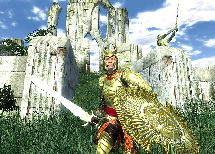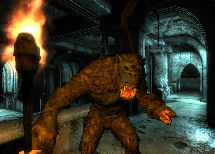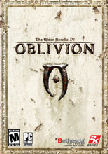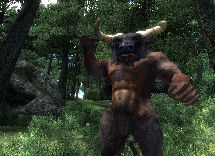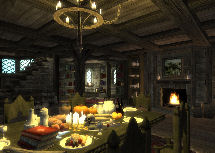“It is epic, it is
huge, it is monstrous, it is...”
Something that we consumers of books, games and
movies can never get enough of are epic adventures. Be it a movie, a book,
perhaps a musical composition or a game, a general consensus is often “The
bigger, the better”. But what is an “epic” story? The original meaning
comes from “epos”, I believe, which is “a long-spanning story told as a
song or verse”. Thus, we can conclude that one of the most ravaged words
of the entertainment scene today is the word “epic”. Since most games and
movies are not truly epic, let us refrain from abusing the word even
further and call them something more fitting...huge? Massive? Monumental?
No matter what we call them, this is exactly what Bethesda’s anticipated
The Elder Scrolls IV: Oblivion attempts to be. So let us not focus
on the constant linguistic misuse of today’s media, but get to the matter
at hand; one of the most anticipated sequels of 2006. Of course, parallels
to The Elder Scrolls III: Morrowind are unavoidable.
Introduction
In terms of story, Oblivion does not have any
connection to its predecessor, Morrowind (but is set in the same
game world). Once again you assume the role of an unknown hero, whom we do
not get to know much about. Starting in a dank dungeon beneath the
Imperial Palace in the Imperial City of Cyrodiil, this poor character soon
becomes a pawn of prophecy (why is it always prophecy?). The Emperor is
murdered and coincidentally the Player Character happens to be there and
is assigned the task of delivering a strange amulet to an unknown person
far out in the countryside. Not quite unlike the first part of
Morrowind, where you were told “deliver this”, but otherwise left to
your own devices.
This is also the game’s greatest strength; there is
no pressure of having to deliver the amulet before a certain date, no
highlighted pink arrows pointing the way and no friendly advisers to lead
you. Once out of the Imperial Palace, there is an entire world to explore,
lots of people to meet and even more to do...for there is much to be done.
Travel the world
Indeed, the game world is huge. There are seven
major cities to travel to, the Imperial City (which is probably as big as
two of the smaller ones put together) and of course an untold number of
smaller villages, caves, old mines, fortresses and camps. The major
improvements from Morrowind here are the network of roads that
allows easy access to the populated areas of Cyrodiil, and of course the
new ability to “Fast Travel”. Fast travelling is simply opening up the map
and clicking somewhere you have already visited (or if it is a major city,
which are always available) and you will be taken there immediately. No
more useless trudging about in the wilds looking for a certain place that
is “somewhere around here”. Hardcore-players may scoff at this and claim
that this is not the “real” way of playing a game. To everyone else –
those who do not think running for hours on end is their idea of having a
good time (having fun is the reason we play the game, is it not?) - it is
a welcome relief.
The player can now also purchase (or acquire) horses
for use when travelling, which is a great help in reducing the amount of
time travelling.
The world itself is a marvel to behold. Forests
covering mossy grounds, snow-covered mountains with narrow stone paths,
steep mountain slopes rising above shaded forests below, billowing hills
and rivers that run deep into the countryside. All this, combined with
solid weather effects and a beautiful night-and-day-cycle guarantees an
immersive graphical experience. A fine example would be to watch the
sunrise by the docks of Anvil, when you can almost smell the salty sea in
the air and feel the chill of early morning.
The life of Cyrodiil
With all this, a justified concern is “Did the
developers then focus all their efforts on the landscapes so it is no more
than a virtual travel-guide?” to which the answer, thankfully, is no. One
thing that is obvious, even at a first glance, is how the designers wished
to give each city and each part of Cyrodiil a “personal” touch. For
example, in Cheydinhal a dark, exotic, sharp style is predominant, being a
city of dark elven influence. In Bruma, which is mostly inhabited by Nords,
wooden log houses and a northern style is favoured. In Bravil, the filthy
impoverished town, most buildings are half-rotted wooden dwellings. The
detail on the outside is at the very least matched by the attention paid
to the interior of the buildings as well. Fireplaces, sets of furniture,
silverware, fruits, candles and everything to be associated with these
medieval-and-fantasy-design houses have been included.
However, despite their very “own” design and style,
it would have been nice to see something more characteristic of the
inhabitants as well. One fitting detail is the Skooma Den in Bravil, which
is basically an apartment for abusers of Skooma. It succeeds in conveying
the run-down atmosphere the town is supposed to convey. While there are
different kinds of characters and races in the different cities, they do
not act in a characteristic way in regards to where they come from. A more
characteristic behaviour of the inhabitants of each city would have
complemented the aesthetics well.
The cities are full of life; guards are patrolling
the streets both day and night. Citizens do not wander around aimlessly as
they used to, but go about their own daily business. They work in the
fields, go to church, sleep, eat and converse with each other. There may
not be a whole lot of variety in it, but it certainly is a great addition
to the feeling of actually being in a city of life and not just a city of
mindless wandering drones. There are also short conversations between them
as they stop and chat about the rumours or the troubling news from the
countryside. These conversations are often of the kind where they do not
even talk about the same thing, and repeat the same dialogues over and
over. Still, it is a commendable attempt at bringing life to the
characters.
Add to this the many books in the game consisting of
knowledge and history of the game world, and for the one desiring such
lore this is a feast.
Another not-so-desirable issue is that the
developers seem to have forgotten the world outside the cities; apart from
the occasional highwayman or soldier on patrol there is little to no
humanoid life. Of course, hunting deer can be satisfying in a way, but
more activity outside the cities would not be unwelcome.
As mentioned earlier, there are also a great number
of underground complexes and caves to sneak or mow through. The atmosphere
of a deep underground tunnel is something the developers have managed to
convey. Haunting music, environmental sounds and a flickering torch - much
like something straight out of an old adventure movie – ensures an
interesting experience. At least it does at first. The layout and design
of the cave complexes are not exactly the same, but it feels as if the
patterns repeat themselves, often giving the player a feeling of deja vu
when exploring.
One thing that would have been welcomed is more
massive and varying underground sites, such as the sunken cities in
Morrowind. Such a thing is something that – if done right – awes the
player and manages to instill a feeling of curiosity and wonder at the
same time.
Quests, factions and story
There are a huge number of quests in the game, of
which the numerous joinable factions provide the majority. There is
usually no limit as to how many factions you can join, and each has a
series of more or less complicated tasks for the player to complete. With
the completion of these quests, the player is given more respect as he/she
advances through the ranks, usually to some kind of master or overseer.
Unlike Morrowind, however, the choice of
faction is not involved in the story of the game, and you can arbitrarily
join any factions you wish. Despite the freedom this offers, one can
question its plausibility; that the Fighter’s Guild would allow someone
who is also a Listener of the Dark Brotherhood to join? Or the Thieves’
Guild, who seem especially vehement about aforementioned Brotherhood?
While not a great problem, it limits the replayability value of the game.
Instead of forcing the player to make a choice between which factions
he/she wishes to join, all is served on a silver platter. To make the mess
worse, some factions are seemingly for nothing more than show (e.g.
Knights of the White Stallion), and it feels cheap to have bundled them in
there with the rest, seeing as how you can never advance or receive new
quests in them.
Quests are also randomly found in the cities or the
wilderness - mostly by speaking to the right person and learning something
vital. Two thumbs up to Bethesda for keeping most of the undertakings in
the cities this time instead of involving stray orcs standing in the
middle of nowhere.
To help with the quests, a thorough and detailed
journal exists. Much more easily handled than in Morrowind, it is
easy to keep track of the active and completed missions. The only downside
is that it all too often tells the player exactly what needs to be done
and how to achieve it. There is now also an arrow by the compass to help
navigate the world. This arrow indicates both map markers and quest
objectives. An option to turn this off should definitely have been
included. Pointing in the right direction of a map marker is one thing;
continuously following the current objective is another thing entirely.
There are a great number of quests indeed, but very
few can be completed in different ways, which is a shame. The result is
that the game play tends to get one-sided and becomes nothing more complex
than just a series of quests, one upon the other. Neither do the quests
have any seeming effect on the world except perhaps a few more
conversation lines from the NPCs (Non Player Characters) in the game. A
special annoyance is that for many quests it is a requirement to be
proficient in the use of lock picks, thereby forcing the player to spend
precious skill points there instead of other areas. A pure fighter will
have a hard time finishing these quests only because there is no other way
around an obstacle.
In all, it sometimes feels as if the designers’ time
should have been spent on fewer factions and quests, tightly weaving them
together instead of spreading everything out.
Although rising in the rank of the factions feels
rewarding indeed, you are often left wondering if the developers perhaps
bit off more than they could chew, so to speak.
Not much that you do in the game truly affects the
story. There is no good or evil way of finishing the tasks - which makes
for very limited replayability. Your renown is measured in fame and
infamy. Quite self-explanatory, but there is no way for truly evil
characters to play the game in a satisfying way. Thanks to the large
numbers of quests, perhaps this is complaining about gold because there
are diamonds. But it is all very linear with no alternate paths.
Being downright evil scum simply does not have
enough impact on the world.
The fact that you can pay a fine and get away with
any murderous act whatsoever is no improvement either. In Morrowind,
the High Ordinators would approach and declare your death sentence if your
crime was grave enough, but here it is simply: “You killed ten men, five
guards, drank two kegs of Skooma and mutilated a little girl and her pet
cat. Pay the fine and be off with you.” Hardly logical, is it?
Also annoying is that quest characters cannot be
killed, only knocked unconscious. Where is the sense in not implementing a
function that updates the journal and saying that the relevant character
is dead and that the quest cannot be completed?
As for the story, in itself it is nothing out of the
ordinary for these kinds of games. Without divulging too much, the player
character once again has to set out on a crusade against a great evil that
threatens the very realm of Tamriel, involving secret plots, cults and
demi-gods. Does it sound familiar? Indeed it does, but the writers of
Oblivion deserve praise for the diversity of these plot-related
quests. Much more varied than the faction-quests, they involve
investigations and infiltrations as well as more regular battles.
The script itself is of varying quality, sometimes
well written and seldom worse than mediocre. The attempt at giving the
main characters as much personality as possible pays off well.
Wherever Sean Bean is at the moment, nursing a hefty
check from Bethesda, it was a smart move to include him in the cast. He is
as good a voice actor as he is convincing in playing his role. Thanks to
him and some golden moments from the writers, a sense of participating in
something monumental that will change the way of life for the continent
actually instills itself.
It also should be noted how attempts have been made
at keeping the general populace up-to-date with news. Deeds that are of
big enough importance will be discussed by other characters, and sometimes
are even written about in the free newspaper. Some small inconsistencies
exist, and it gets tiresome to listen to the same exploits discussed
months after they actually happened. But these are minor annoyances. It
feels gratifying to be in a world where the population does not simply
know that you have done good deeds, but talks about them as well.
Combat and aspects of
Roleplaying
As for the game play itself, not much has changed
since the predecessor, and therefore Oblivion has inherited the
same problems. Fighting is still done by executing different manoeuvres
with the mouse and keyboard, but it often comes down to frenetic clicking,
hoping to strike your opponent before he strikes you. The special attacks
are rarely of much use because of their clumsiness, and are ill suited for
an action-RPG such as this one. This is probably the weakest aspect of
Oblivion – the melee combat.
As always, dispatching monsters and adventuring is
bound to boost your character. The system for levelling up is on the whole
unchanged. When starting the game, the player chooses major skills and a
star sign giving him or her special abilities. When a certain number of
new levels have been reached in the major skill classes, a new character
level is achieved, allowing the player to boost his or her physical
attributes as well.
An improvement is that trainers can no longer train
an infinite number of times per level. Assuming that one had enough gold
and that the trainer was of sufficient skill, there was no limit to the
number of times the trainer could be used in Morrowind. Here,
however, there is a limit of five training sessions per level, which
prevents extensive power levelling and forces the player to actively seek
out quests and adventures.
On the subject of such things, to keep you from
becoming a demi-god yourself among goblins and rats, Bethesda has included
a system, which spawns creatures based on your current level. In general,
this is a well-implemented system and the foes get considerably tougher as
levels are gained.
The interface of the game is a step down from what
it was before. Morrowind had an easily accessed and easily
navigated inventory and interface system. So why change a winning concept?
A panel with enormous buttons and confusing symbols has now replaced the
straight-to-the-point interface. Hard to navigate, and the inventory
system is especially frustrating as it requires extensive scrolling to
browse through the inventory.
Technicalities
Graphically, there is nothing to complain about. The
environmental effects, attention to detail and even facial expressions are
all astounding, assuming you have the hardware required for them. Even
running at the lower settings, these manage to impress. The only possible
criticism is that the humans of Cyrodiil do not look very human, but the
overall quality of the graphics is indisputable.
The audio aspect of the game is a mixed bag. A few
sounds are truly well made - especially the haunting sounds of wraiths and
the rumbling of stone in old ruins. The voice acting is well done, but
there are far too few different actors to make it believable. It’s hardly
convincing when every third character has the same voice. Granted, there
are too many characters to find a way to make this entirely believable but
that does not change the fact that hearing the same voices does feel
awkward at times.
Oblivion lacks
environmental sounds; crickets, birds and animals. Often the only ambient
sound to hear is the howling of snow or splashing of rain (which are well
done).
To cover this up, Bethesda has once again hired the
famed Jeremy Soule to compose the music. The regular battle and journeying
music is good, but gets tiresome after a while (the soundtrack is not that
long, after all). It is in the caverns and other haunting places that the
music truly stands out. Droning choirs and massive oppressive sounds
combine to make the journey through old tunnels and ruins a memorable one.
Bug-wise, the game is not as bad as might have been
expected. Personally, I have only encountered one quest-breaking bug,
which had to be fixed using console commands. But according to the
official forums there are many more. It is always a shame when a game is
rushed, but what is done is done. A patch has long been released, and
should fix most problems. However, a far larger and more complete
unofficial patch has also been released which is warmly recommended.
A note is also in order regarding modifications. A
large number of these have been released, and their uses range from fixing
small bugs to improving the general performance of the game to reverting
the interface back to the old Morrowind interface. Downloading
these can solve many of the annoyances and/or problems in Oblivion,
and since they are most often easy to use and not big to download, this is
definitely something to think about.
All in all...
In conclusion, Oblivion is a rather solid
game, worthy of attention of anyone wishing for a light-hearted adventure
with an entire world to immerse oneself in. The combat system is
frustrating, but that is secondary. Oblivion’s real strength lies
in the total freedom of action it provides.
Despite the game’s numerous flaws, it is easy to
become engrossed in the world and it’s atmosphere. However, don’t expect a
very deep game or one that will continuously pull you back for another
round.
84%
January 2007
design copyright ©
2007
GameBoomers
Group
